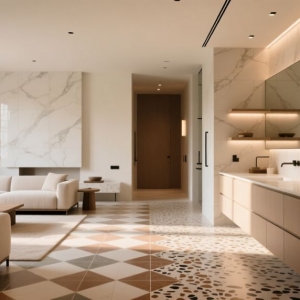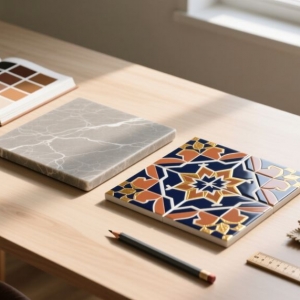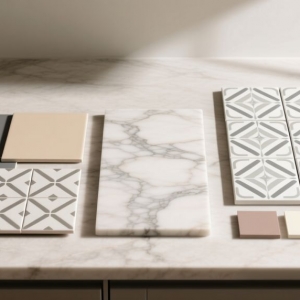Marble’s luxurious allure makes it a favorite for elegant interiors, but humidity can dim its shine. If you live in a coastal or tropical region, you’ve likely seen marble surfaces—like a large marble slab for wall decor or luxury wall tiles—battle issues like mildew, stains, or dullness. With a consistent care routine, you can keep your marble looking flawless. Here’s how to clean and protect it in humid environments.
How Humidity Affects Marble
Marble’s porous structure makes it susceptible to moisture. In humid climates, water from steam, spills, or ambient air can seep into the stone, causing etching, discoloration, or mold growth. Grout lines are particularly prone to mildew, especially in bathrooms or kitchens. Premium installations like luxury wall tiles or a large marble slab for wall use require diligent maintenance to stay pristine in damp conditions.
Dry Daily to Prevent Damage
The first step to protecting marble in humid climates is keeping it dry. Wipe down marble surfaces daily with a soft, dry microfiber cloth, especially in high-moisture areas like bathrooms or kitchens. Pay close attention to spots where water collects, such as near sinks or the base of a large marble slab for wall installations in showers. Even brief exposure to standing water can lead to stains or sealant damage.
Avoid leaving wet items like towels, sponges, or soap bottles on marble surfaces. A quick daily wipe-down prevents moisture from penetrating and reduces the risk of mold.
Clean with a Delicate Approach
Marble requires gentle cleaning to maintain its elegance. Avoid acidic cleaners like vinegar or lemon-based solutions, which can etch the stone, and steer clear of bleach, which can cause discoloration. Use a pH-neutral cleaner designed for natural stone, or mix a few drops of mild dish soap with warm water. Wipe the marble with a damp, soft cloth, rinse with clean water, and dry immediately to prevent water marks.
This method is critical for luxury wall tiles, where even minor scratches or chemical damage stand out. Don’t let cleaning solutions linger, as they can penetrate the stone if not rinsed promptly.
Seal Regularly for Protection
Sealing is essential in humid climates to shield marble from moisture. A high-quality sealant creates a protective barrier that repels water and prevents stains. In drier regions, sealing once a year may suffice, but in humid areas, reseal every six months. This is particularly important for light-colored marble or luxury wall tiles in high-traffic areas like bathrooms or kitchens.
To test if resealing is needed, sprinkle a few drops of water on the marble. If they bead up, the sealant is effective. If they soak in or darken the stone, apply a new coat of stone-specific sealant, ensuring the surface is clean and dry before starting.
Care for Grout Lines
Grout is often the first to show wear in humid conditions, becoming a hotspot for mold and mildew. Seal grout every six months alongside the marble to keep it protected. For cleaning, mix a paste of baking soda and water, apply it to stained or musty grout, and let it sit for a few minutes. Scrub gently with a soft brush, rinse thoroughly, and dry completely.
Avoid harsh chemicals or abrasive tools, as they can damage both the grout and the surrounding marble. Regular grout maintenance ensures your marble installation remains spotless.
Promote Air Circulation
Ventilation is a powerful tool for protecting marble in humid spaces. Stagnant, moist air encourages mold growth, even on sealed surfaces. Run exhaust fans during and after showers or cooking to reduce humidity. A dehumidifier can help in consistently damp rooms. Open windows when the outdoor air is less humid, and use ceiling fans to keep air moving. This is crucial for large marble slabs for wall use, where trapped moisture can cause hidden damage.
Avoid Common Oversights
Marble damage often stems from small, preventable habits. Don’t let wet items like soap dispensers or damp cloths sit on marble surfaces, as they can cause stains over time. Clean spills immediately to prevent etching. Avoid abrasive scrubbers or generic household cleaners, which can strip the sealant or scratch the stone. Regularly dry areas prone to water buildup, like shower corners or sink backsplashes.
Polish with Restraint
If your marble loses its luster, a marble-specific polish can restore its natural glow. Use it sparingly with a soft cloth, following the product’s instructions carefully. Over-polishing or using the wrong product can harm the surface, so aim for a subtle, natural sheen rather than an overly glossy finish.
Seek Professional Help When Needed
For deep stains, persistent mold, or severe etching, DIY solutions may fall short. Attempting to sand or chemically treat marble yourself can worsen the damage. Hire a stone restoration specialist, especially for high-value installations like luxury wall tiles or a large marble slab for wall use. Professionals have the expertise to restore marble safely and effectively.
Final Thoughts
Marble can thrive in humid climates with consistent care. Dry it daily, clean it gently, seal it regularly, and ensure good airflow. These simple steps protect your investment, keeping your marble—whether it’s a large marble slab for wall decor or exquisite luxury wall tiles—stunning for years to come.











